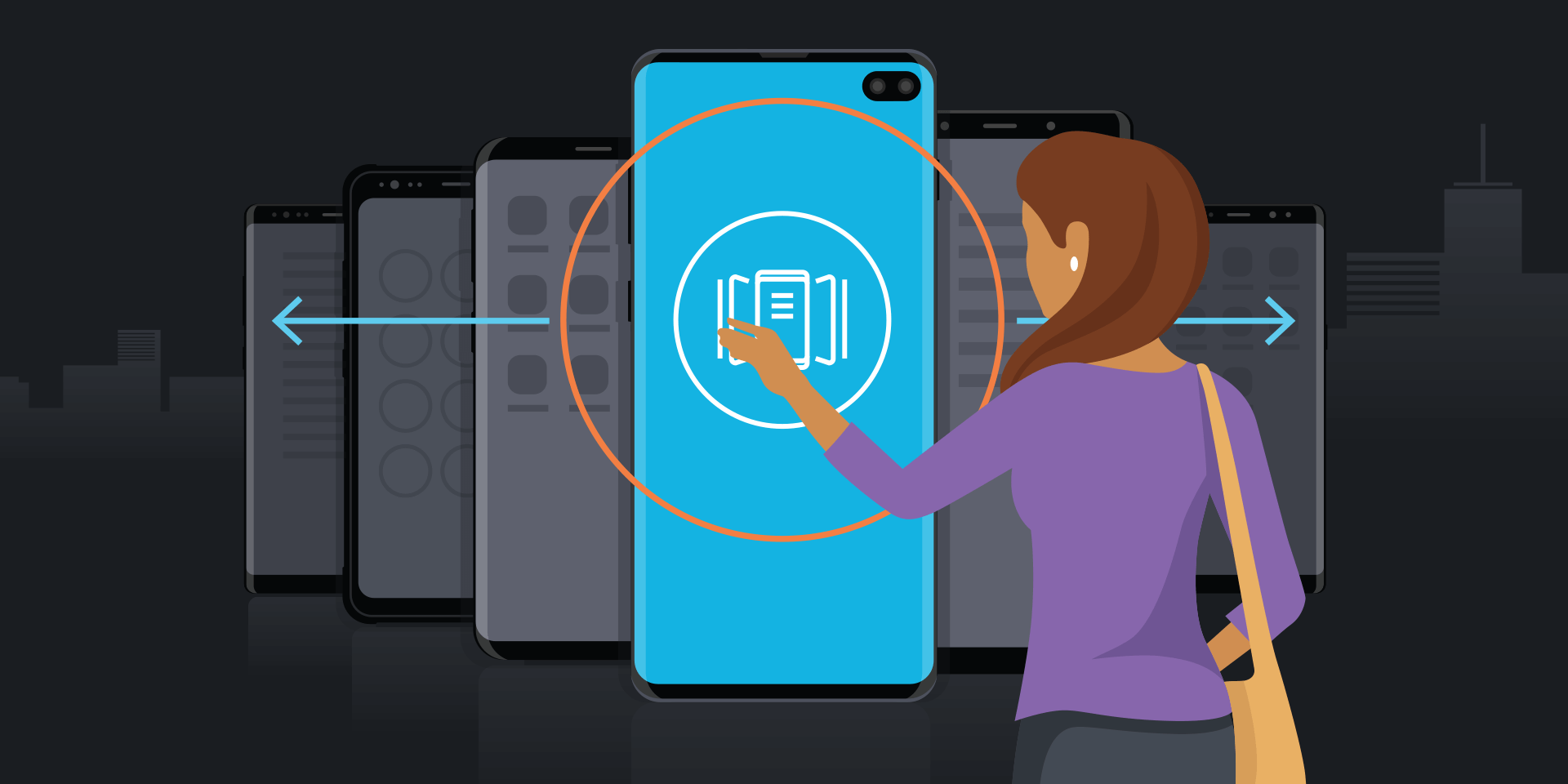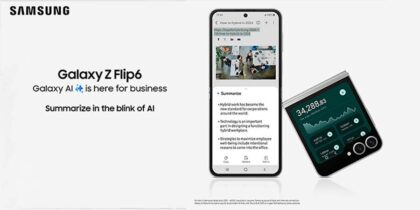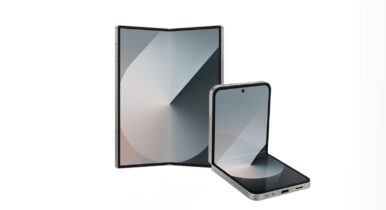With the continued rollout of 5G infrastructure nationwide and broader availability of compatible mobile devices, many people will experience 5G wireless connectivity for the first time in 2021. Much like the shift from 3G to 4G, this next generation wireless standard represents a significant leap in data speed as well as a reduction in latency. But to the average user who already enjoys quick downloads and smooth HD video streaming on a 4G LTE phone or tablet, is 5G all that different?
This guide will provide a primer on 5G, going beyond the debate over download speeds and looking at how it will change mobile usage — particularly in the business context. We’ll cover the origins of 5G and how we arrived at this unprecedented era for mobile. You’ll also discover how 5G works, when you can expect to see broad adoption, what benefits it can bring to you and your business, and why this technology has the power to transform almost every industry it touches.
Click the links below to jump straight to the section that interests you:
- What is 5G and how did we get here?
- How is 5G different from 4G?
- What spectrum is used for 5G?
- What 5G devices are available Today?
- Beyond speed, what are the benefits of 5G?
- What are some key use cases for 5G?
- When is 5G arriving?
What is 5G, and how did we get here?
5G refers to the fifth generation of wireless communications and network deployments aligning to 3GPP standards. This next-generation mobile network, which has already rolled out in many cities in the U.S. and around the world, is poised to pave the way for a new era of connectivity with a wide range of exciting new uses.
The first generation of wireless cellular technology (1G) was introduced back in 1979 and utilized the 800MHz spectrum. 1G arrived in the United States four years later, with cellular towers coming down from mountaintops to our streets. The second generation (2G) was introduced in 1991, adding the 1.9GHz spectrum. 2G introduced text messages and the capacity to share images and videos (MMS).
3G then added the 2.1GHz spectrum and implemented technology that would allow for much higher bandwidth. This technology, known as multiple input multiple output (MIMO), added additional antennae to cellular equipment, permitting an increased level of capacity for devices and bandwidth. Theoretically, 3G could achieve speeds just above 40Mbps.
The fourth generation (4G) was commercially deployed in 2009 and utilized primarily 700MHz and 5.2GHz frequencies. The big difference between 3G and 4G was the drastic increase in speed. While 3G offered theoretical speeds around 40Mbps, 4G offered up to 400Mbps, providing dramatically greater capabilities to mobile devices.
5G is the fifth generation of wireless cellular technology. It operates within the 600MHz, 2.5GHz, 28GHz and 39GHz spectra.
Ted Ross, CIO for the City of Los Angeles, explains that 5G cell towers (also called small cells) in many cases are smaller than 4G cell towers and require less power to operate. “However, in order to increase the speed and reliability, 5G requires drastically more small cells across your city,” Ross said. “With speeds as high as 4Gbps, the opportunities for applying 5G technology will expand to applications such as remote vital sign monitoring, automobiles, city infrastructure, telemedicine and even remote surgeries.”
Theoretically, 5G speeds can reach 20Gbps. While it’s not at this range yet, real-world deployments have achieved 2Gbps in commercial network speed on mobile broadband — a substantial achievement.
Given the increased density of cell sites required for hyperfast 5G, smooth handovers are essential. In 2019, Samsung demonstrated high-speed handovers between 5G cell sites on a racetrack in South Korea, with a car moving at 130 miles per hour able to download at up to 1Gbps using the 28GHz band.

How is 5G different from 4G?
Compared to 4G LTE, 5G offers three significant upgrades: connection speeds 10 times faster, much lower latency and the ability to connect a massive number of devices simultaneously.
Just like 4G, 5G starts with the internal antennae in smartphones and other smart devices. “These antennae send and receive radio frequency to and from cell towers or small cells, which have multiple antennae to receive and transmit signals to dozens of devices,” Ross explained. “Once a tower receives these signals they are then transmitted across the provider network and find their way to the intended destination, whether it be phone, website or another device. 5G, however, is ultra-fast and ultra-responsive compared to previous cellular connections, allowing mobile devices unimaginable connectivity and capabilities.”
In order to explain how 5G works, it’s important to start with a few mobile network basics. Mobile networks have two primary elements: the radio access network (RAN) and the core network.
The RAN is comprised of different facilities including small cells, macro cells, towers, masts and dedicated in-building and home systems to ensure mobile users and wireless devices are connected to the core network.
Small cells play a key role in 5G networks, specifically to help facilitate short connection ranges for new millimeter wave (mmWave) frequencies. These small cells will be clustered wherever mobile users or applications require the fastest connections and will provide continuous connections.
5G macro cells, on the other hand, are using new technologies like massive MIMO antennae and beamsteering, which use multiple antennae for sending and receiving data streams to multiple users. For mobile users, it means more people can simultaneously connect to the network and maintain high throughput.
What's the best phone for your business?
Take this quick assessment to discover the smartphone most tailored to your business needs. Take Assessment
5G relies on massive MIMO antennae, already available for 4G LTE but organic to 5G. Massive MIMO provides the best data experience for mobile users by optimizing the number of data layers.
The core network is the mobile exchange and data network managing mobile voice, data and internet connections. With 5G, this redesigned network is better suited to integrate with the internet and cloud-based services and also includes distributed servers across the network — improving response times and reducing latency.
Many of the advanced features critical to 5G’s success include network slicing and network function virtualization, which will be used by different applications and services and managed in the core.
Network slicing allows for specific types of network traffic to be carved out — or sliced — to match different use cases. Network traffic can be tailored to customer requirements and use cases, whether it’s consumer, enterprise, public safety or internet of things (IoT). Mobile traffic can be divided like a pie: one slice for a consumer-centric application like video streaming, social media and nonreal-time data; another slice for public safety applications like high-quality augmented reality (AR) for first responders and yet another slice for high-end machine-to-machine (M2M) use cases for IoT services requiring extended coverage and low bandwidth. In a potential B2B2C scenario, a video streaming service could pay carriers for a slice and an improved quality of service (QoS) and quality of experience (QoE), then pass that cost to the subscriber as part of a new subscription model.
Network function virtualization (NFV) enables network functions that were previously hardware-driven to operate on commercial off-the-shelf (COTS) technology. Network functions like a firewall, which used to rely on dedicated hardware, can now operate within a virtual machine as a form of software. To enable the speed, agility and efficiency to support the myriad of new business applications, NFV is a critical element of the 5G core and more and more functions of the RAN are being virtualized as well.
What spectrum is used for 5G?
The spectrum is a frequency channel which carries data between your smartphone or internet-connected device and the antennae. The two main spectra that are being leveraged for 5G are mmWave and Sub-6. Sub-6 represents the low and midband spectrum, using frequency bands under 6GHz. While it doesn’t have the top-end speeds of mmWave, Sub-6 spectrum has coverage advantages while still supporting high throughput. On the other hand, the mmWave spectrum has not been widely used so it still has more contiguous channels (bandwidth), making it well-suited to supporting capacity and ultrafast speeds at shorter ranges.
The initial 5G standard and network architecture allows 5G and 4G to work together. When a mobile device connects to the 5G network, a connection is also made to the 4G network to provide the control signaling, while 5G provides the fast data connection and attaches to the existing 4G signal.
If 5G coverage is limited, the data would be carried on the 4G network to ensure continuous connection. Essentially, 5G can complement the existing 4G network.
What 5G devices are available today?
Although 5G devices only accounted for about 1 percent of global smartphone sales in 2019, Counterpoint Research noted that 5G device penetration had already reached just over 13 percent in Q3 2020, and projected that 5G phones would ultimately represent 20 percent of all smartphone sales for the full year.
Samsung has been the front-runner in the release 5G-capable mobile devices, shipping more than 6.7 million 5G devices in 2019 — more than half of the global market at the time.
In April 2019, Samsung introduced the Galaxy S10 5G, the first 5G-capable smartphone. With the Galaxy S20, announced in February 2020, Samsung moved its entire flagship line to 5G — and they quickly became the top-selling 5G smartphones on the market.
Samsung has also brought 5G to its more affordable Galaxy A Series lineup, with the launch of the Galaxy A71 5G.
On January 14, 2021, Samsung further expanded its 5G line with the reveal of the Galaxy S21 Ultra 5G.
5G connectivity isn’t limited to phones. In 2020, Samsung launched 5G variants of its Tab S7 and S7+, the first 5G tablets in the U.S. market. As things evolve, expect 5G endpoint devices in cars, AR headsets and many more devices to make us more connected than ever before.
Many new mobile devices utilize Qualcomm’s 5G-capable chipsets. For example, the Galaxy S20 series sold in the U.S. incorporates the Snapdragon 865 platform and the X55 modem. Qualcomm described the X55 as the world’s first commercial modem-to-antenna 5G solution for consistent, lightning-fast speeds across the board, with peak speeds of up to 7.5Gbps.
Samsung has also developed hyperfast 5G modems. Outside of the U.S., the Galaxy S20 series features the Exynos 990 processor with the Exynos 5123 modem, which is rated for download speeds of up to 7.35Gbps in mmWave and 5.1Gbps in sub-6GHz setting with up to eight-times carrier aggregation.
“Samsung has established itself as a leader in the 5G space, and played a key role in the development of 5G around the world,” said Neil Mawston, Executive Director at Strategy Analytics. “With global 5G smartphone shipments expected to exceed 660 million devices by the end of [2021], we believe the company will continue to play a significant role in growing the next-generation mobile network.”
Beyond speed, what are the benefits of 5G?
While speed may be simple to quantify, 5G’s capabilities for low latency and ultrareliability are slightly more complicated to illustrate. Here’s where comparisons can be made to Wi-Fi, where you don’t have predictable latency — in other words, how long it takes to send data from one point to the next, typically measured in milliseconds (ms).
Latency is an underrated component of 5G and is often confused with bandwidth. When comparing latency to bandwidth, an analogy can be drawn to a freeway: Bandwidth would be the size of your highway, while latency would be the roughness of the terrain you’re trying to drive over.
Compared to 4G, latency for 5G is reduced by 5,000 percent. While 4G is limited to 50ms, 5G should achieve around 1ms once fully developed. In comparison, 3G offered a now sluggish 100-500ms.
“With 5G, we’ll see latency less than 10 milliseconds,” said Derek Johnston, head of marketing and 5G business development at Samsung Networks. “When you talk about this ultralow latency, it’s essentially a real-time interaction between things that may be thousands of miles away. It will allow for vehicle-to-vehicle type applications for autonomous driving and so much more.”
Another exciting aspect of 5G for enterprise is the ability to support 1 million connected devices in a square kilometer. “While that may sound like an unlikely number of connected things,” said Johnston, “in dense urban cities, between everyone with a phone, a wearable or two of some kind, and you add connected CCTV, C-V2X and other smart-city devices like streetlights and meters into the mix, it’s not difficult to concentrate a large number of connected devices in a small geographical space.”
What are some key use cases for 5G?
From transportation and manufacturing to healthcare, hospitality and even smart cities, hyperfast 5G is creating new opportunities and use cases that will change the way you do business. Here are a few examples we can look forward to.
- Productivity power: The workforce of tomorrow is on the verge of substantial changes. With 5G, businesses will be able to leverage technology to hold VR meetings or even deploy AI-enabled tools via cloud-based apps to accelerate workflow. Now that more employees than ever are routinely working remotely or on blended schedules, there is an increased reliance on mobile devices for productivity. When you combine 5G with a platform like Samsung DeX, employees can work efficiently from anywhere.
- A game changer in facilities: Organizations in large buildings are positioned to benefit significantly from 5G technology. The greatest impact would be noticed by facilities with large numbers of connected devices and high volumes of data transferred. Given the inherent issues with connectivity due to the amount of concrete, wiring and radiation, 5G facilities would benefit any such major campus. In one hospital in Chicago, for instance, they’re leveraging cloud-based multiaccess edge computing (MEC) services to help the hospital system manage its cellular traffic over both LAN and WANs. The ability to practice remote medicine and to download large lab files is already here for some facilities.
- Autonomous Vehicles: Vehicle-to-Everything (V2X) technology will underpin the emerging era of autonomous vehicles. With 5G technology delivering reduced latency, vehicles will receive real-time updates on hazards that develop beyond the line of sight, allowing vehicles to respond safely and immediately.
- Turning AR/VR into a business reality: Whether it’s a VR headset or AR camera capabilities, 5G will transform business by delivering content to an abundance of devices at once. With faster speeds, low latency and improved connectivity, organizations can leverage AR and VR to incorporate entertainment, education or on-the-job training into their business strategy. When combined with AI, content can be deployed live, dynamically and at scale to offer benefits never before realized for teams and collaboration. Not only that, content can be adaptable to each employee or customer based on their preferences.
- Retail revolution: For brick and mortar retail, 5G represents a tremendous opportunity for groundbreaking technologies to transcend retailers with large budgets and reach “mom and pop” operations. Loyal shoppers can be rewarded with personalized offers based on their previous purchases, and those offers may even appear on their mobile devices as they approach a particular product. 5G’s high speed and low latency open the doors for retailers to create customized offers and experiences for customers to maintain and build upon engagement throughout the next decade.
When is 5G arriving?
AT&T, T-Mobile, Sprint and Verizon are all rolling out 5G across the U.S., and depending on where you live, 5G may already be available. As of January 2021, access covers well over 50 major metropolitan areas on one or more carriers. This roll out will continue rapidly throughout 2021 and beyond. Here’s are some of the latest updates from the major carriers:
- In November 2020, Verizon announced its 5G service is available in 57 cities nationwide. Verizon’s 5G network is also now accessible in 24 professional football stadiums and indoor arenas primarily used for hockey and basketball games.
- In November 2020, T-Mobile announced its 5G network provided coverage to more than 270 million people, with Sub-6 coverage alone reaching over 410 cities and towns.
- AT&T offers 5G services leveraging both mmWave and Sub-6 bands. As of July 2020, its mmWave-based 5G+ service was available in parts of 36 cities, while 5G leveraging Sub-6 is live for at least 58 markets.
Unlimited potential
2020 was the year when 5G moved from buzz to reality. “We are only starting to see the benefits of 5G,” says Johnson. “As the ecosystem develops and we get more awareness, we’ll be able to bring the new use cases to life and really prove them out. But we’ve still got work to do to build out the networks and continue to expand the device portfolio.”
As the work gets done, there are countless use cases that are poised to harness this truly transformative technology. There’s a business use case for nearly every industry, even public safety. Imagine the ability for first responders to send robots into burning buildings — complete with sensors and HD cameras — to locate people in need of rescue. Not only that, smart cities will become smarter, as local leaders can leverage 5G-enabled sensors to report instant data on traffic, environmental conditions and public safety.
Samsung has worked to bring 5G from the lab to the real world by working closely with carrier partners, regulatory groups and government agencies to develop the best 5G experience possible. It has also been a leading contributor to industry groups like 3GPP and O-RAN Alliance, and shown a commitment to an open, collaborative approach to networking, which has helped to accelerate delivery of 5G to consumers and businesses.
“Samsung has been one of the leading players catalyzing the 5G market development,” says Neil Shah, VP of Research at Counterpoint Research. “With tremendous 5G growth opportunities on the horizon, Samsung, over the next decade, is in a great position to capitalize by further investing and building on the early lead and momentum.”
5G is only getting started. The possibilities are endless and exciting.
Learn more about how Samsung is leveraging 5G with the Galaxy S21 Ultra 5G, and dive into the networking technology that supports 5G.








